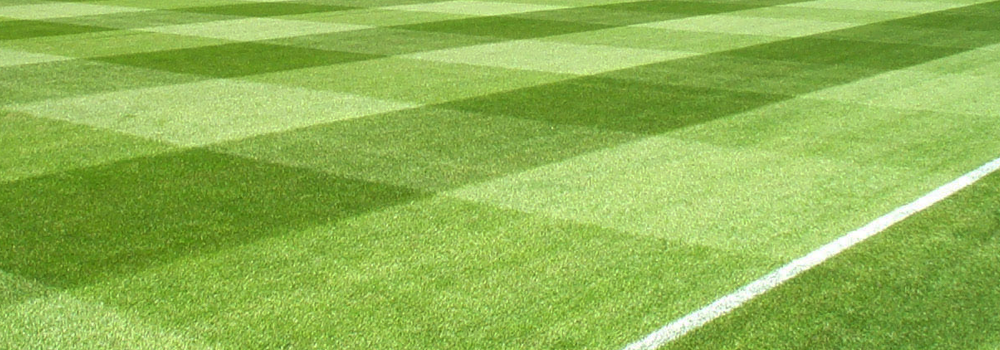
Air temperatures should continue to be high during August, so it is important during these periods of hot weather to keep the grass plant well-watered.
Many rugby union clubs will be on final pitch preparations now, including setting out and initial marking of your pitches. Always double check your measurements before committing to a white line!
Check that your goal sockets are set in line with the base line and are upright. Correct this now to ensure a professional look.
Key Tasks for August
- Maintain sward height at 30mm-75mm; the top height will cushion heavy falls on any hard ground.
- Mowing will increase as soil and air temperatures continue to stimulate grass growth
- Invest in fertiliser if you have the budget. The more growth you can get the better; regular cutting will thicken the sward and help produce a better pitch coming into the playing season.
- Applying a summer N P K fertiliser, something like a 12:0:9, to maintain grass colour and vigour. A slow release fertiliser could be applied to see you through August and September.
- Ensure that all areas are watered uniformly to promote healthy growth. Irrigation will be a priority, especially if maintaining newly sown or turfed areas. It is important to ensure that the water gets down into the rootzone to encourage deep rooting. Allowing areas to dry out can lead to problems of dry patch, a condition that prevents water infiltration into the soil, thus forming areas of non-uniform turf quality.
- Linear aerators now offer alternative methods of aeration to the traditional solid tine spiker and hollow core spiker, which can install a continuous slit 10mm wide 200mm deep at 200mm centres. The machine has also been upgraded to infill with kiln dried sand
- Brush to remove dew and remove surface debris. Using a brush will restore levels and produce striping or banding aesthetics
- Pre-season training will be well underway, with club coaches demanding marked out areas for practices. Ensure you have enough marking materials and an efficient, quality line marker for carrying out these tasks
- Check with your relevant governing body for any amendments to the laws and markings of the pitch
- Care should be taken when initially marking out new lines, ensuring that they are true, straight and measured correctly, using the 3,4,5 method to achieve accurate angles
The following points are essential requirements to help achieve accurate linemarking:
- A reliable, accurate linemarking machine
- Appropriate, approved marking fluid
- Careful planning and preparation (setting out lines)
- Linemarking Training Courses
Pre match inspections:
Pitch surface, linemarkings and posts.
Keep heavy wear areas roped off to stop unwanted early use.
Tidy up the edges of the pitch, strim around advertising signs and crowd barriers. Presentation on the pitch will be let down badly by unkempt edges.




The vagaries of the climate drive all factors with regard to turf management, and increasingly we see extremes of rainfall and dryness with the apparent turnaround from one to the other being short and dramatic.
This places increasing pressure on sports turf ecosystems in the form of biotic and abiotic stress. As a result, it is increasingly important that turf managers are seeking alternative strategies and techniques to mitigate against the effects of these stress factors upon the playing surface.
Warmth and humidity will be sure to activate a number of fungal diseases, from take-all patch, microdochium patch, dollar spot, anthracnose, waitea patch, fairy rings, leaf spot and red thread. Successful management of each disease requires knowledge of the contributing factors and considered, planned proactive treatment;
Increasingly, Integrated Turf Management should be applied to all situations. Practically this may look like the following
Monitor - historic site data – disease predictors e.g. Syngenta’s Greencast – five day weather forecast
Identify - correctly identify the disease, learn about the life cycle and contributing factors.
Plan - create disease management plans predict and mark high risk windows using data from monitoring process – hold stock or treatments.
Do - apply calcium, phosphite and silicon ahead of suspected activity periods. Use your data and monitoring to time fungicide treatments BEFORE you see active disease.
Record - periods of susceptibility, outbreaks, details of treatments.
Review - the success rate, how things responded to different treatments, assess how things can be refined. Short examples for each may include:
Controls and Management Techniques:
Take-all patch – check manganese levels and apply as a little and often foliar treatment - target roots with fungicide.
Microdochium patch - remove leaf wetness, do not promote soft growth.
Dollar spot – avoid low fertility, remove dew.
Anthracnose – avoid stress through drought or low fertility, secondary effect from nematode feeding.
Waitea patch – minimise thatch, improve surface drainage.
Fairy rings – assess for hydrophobic areas in the profile by dropping water down soil cores, target with wetting agents.
Leaf spot – remove dews, do not overfeed with nitrogen, plant resistant cultivars.
Red thread – remove dews, feed to grow out, plant resistant cultivars.
Surface abrasion can facilitate the infection of diseases, so a well-timed systemic fungicide can help to prevent attack.
Nutritionally speaking, maintaining plant vigour without promoting excessive growth is as always the key thing to aim for. It is not too late for a good quality organic based fertiliser which should give consistent results for up to eight weeks. The organic sources will also help to promote and support soil microbiology as we head towards autumn.
Continue wetting agent programmes to facilitate effective moisture management throughout the profile. Seek out evapotranspiration rates during hot spells and irrigate in millimetres not minutes. Your irrigation engineers should be able to provide the relevant information for your sprinklers.
August is peak season for the proactive control of Leatherjackets and chafer grubs with Entomopathogenic nematodes, Considered application as part of an integrated turf management plan, accompanied by a penetrant wetting agent and plenty of available moisture both before and after application will help to get the best out of nature’s practical answer to this problem and prevent issues come spring 2018.
With August typically being a good month for turf and plant growth, now is a good time ahead of the new season to treat weeds with a selective herbicide, post pitch renovations in May and seedling maturation during June.
Red Thread has swept spectacularly through a lot of outfield turf. With such a peak in disease activity in mid-summer we are expecting continued problems over the next few months; therefore acting preventatively by applying a systemic fungicide such as Heritage Maxx will be the most effective form of control. Application before symptoms are visible but the threat is imminent is the key to success when adopting a preventative approach. Red Thread is ill-defined bleached grass with Pink mycelium visible in early morning dew. Close inspection will reveal red needle like structures which are attached to the leaf blades. The needles become brittle upon death and are easily detached allowing fragments to spread the disease.
Systemic curatives and protective fungicides such as Chlorothalonil and Iprodione, applied in liquid form with water as a carrier, can be used to control any outbreaks. Mixing two or more products in the same tank can help reduce the potential for disease resistance developing. Fungicides are selected with different modes of action so that resulting mixture will attack the target disease on two or more fronts. This makes it more difficult for the pathogens to develop resistance to treatments.
Symptoms of Fusarium (Microdochium nival), the most common and damaging disease, are orange/brown patches 2.5-5cm across increasing in size under suitable conditions as the disease progresses. Active patches have a distinctive 'ginger' appearance when viewed early in the morning. Creamy white mycelium resembling cotton wool can be seen in the centre and towards the outer edge of the patch.
Grass in the active patches is often slimy; once the disease is controlled the scars will remain until there is sufficient grass growth to fill in. Regular brushing, switching or drag matting in the mornings to remove the dew from the playing surfaces will reduce the likelihood of disease outbreak.
Please note: More information on these and many others can be found here: www.pitchcare.com/useful/diseases.php
Keep machines overhauled and clean. Ensure you look after your equipment and store safe and secure, it is a good idea to get into a habit of washing down and and cleaning after use.

Our LANTRA accredited Winter Sports Pitch Maintenance Course (Rugby & Football) is now available in an online format.
Like our one day course, it is designed to provide a basic knowledge of rugby and football pitch maintenance. The course enables the Groundsman to grasp the basic needs of a winter sports surface throughout a 12 month period. As an online version, it means you can learn at your own pace and at home. The Course Manual is included as part of the online course.
Delegates attending the one day course or using the online version, and using the accompanying manual, will be able to develop their own skills, working knowledge and expertise, by understanding the method of instruction and the maintenance principles it sets out.
Included in the Course Manual, there are working diaries showing the range of tasks needed to be accomplished each month. The Course Manual is available for purchase separately.
If preferred, we are able to arrange courses to be delivered on site to groups of 6 – 10 people. Email Chris Johnson for information.
We have one day LANTRA accredited LINEMARKING COURSES being held:
Wednesday 23rd August, Basingstoke RG21 3DR and
Wednesday 30th August, Ferndown, Dorset BH22 9EN
Other training courses available include:
Safe Use of Pesticides (PA courses)
Pedestrian operated mowers
Hedgecutters
Brushcutters/strimmers
Toolbox Training
Manual Handling
Please ensure that all goalposts meet health and safety standards. Now is a good time to thoroughly check them over. If you have stored them away, give them a thorough once over to ensure that they will be fit for purpose for the new season. If you find any defects, these must be reported to your management/committee, with appropriate remedies being sought – ahead of the season!
It would be prudent to thoroughly clean out your linemarking kit. If the forecasted showers appear, what better time to do this mundane but important job? Regardless of the type of machine you use, you’ll be pleasantly surprised by how much better your lines will look for the start of the season.
Other areas should also be checked over, such as fences and dugouts.


